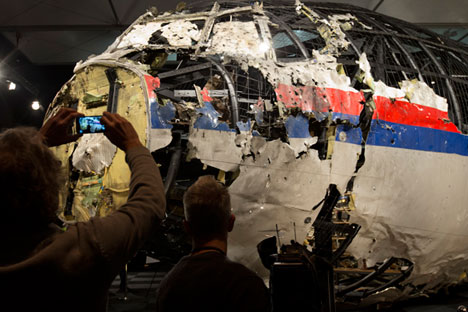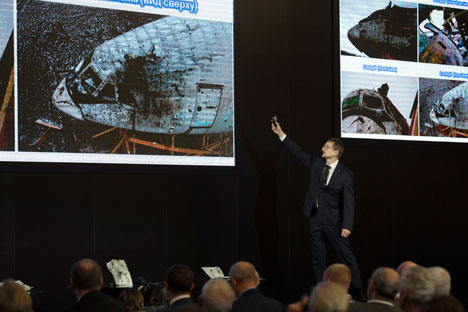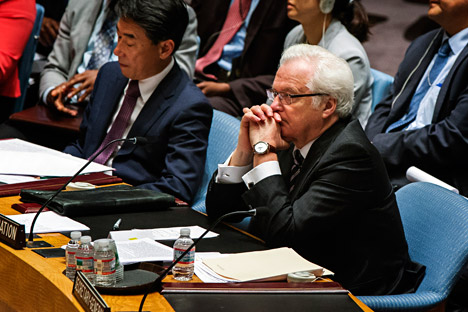Manufacturer of BUK missiles disagrees with Dutch official report on MH17

Journalists take images of part of the reconstructed forward section of the fuselage after the presentation of the Dutch Safety Board's final report into what caused MH17 to break up high over Eastern Ukraine last year, Oct. 13, 2015. Source: AP
APMalaysia Airlines Flight MH17 was destroyed by a Russian-made BUK surface-to-air missile, according to the results of the long-awaited Dutch Safety Board investigation into the shooting down of the passenger jet over the Donbass region of eastern Ukraine in July 2014, which were announced on Oct. 13.
On the very same day, Almaz-Antey, the state-owned producer of Russian anti-aircraft systems, including BUK missiles, presented its own “report” into the disaster, the release of which appeared to be timed to coincide with the publication of the Dutch dossier.
Flight MH17 was brought down on July 17, 2014 over eastern Ukraine while en route from Amsterdam to Kuala Lumpur, killing all 298 passengers and crew, most of whom were from the Netherlands, Malaysia and Australia.
While Dutch specialists, who carried out detailed analysis of the wreckage of the plane for their investigation, during which missile parts were found at the crash site and inside the remnants of the cockpit, say that the plane was hit by a BUK 9M38M1 missile, the Almaz-Antey developers claim it was an older 9M38 missile [both were withdrawn from the Russian armed forces].
The Dutch report does not say who fired the missile.
Airspace should have been closed
According to the Dutch report, the missile detonated on the left side of the plane, a meter from the cockpit. Parts of the missile were found in the pilots' bodies, noted Chairman of the Dutch Safety Board Djibbe Joustra during the presentation of the results.
The Dutch report says that airspace over eastern Ukraine should have been closed to civil aviation, since military activity was taking place in the territory and several military planes had been shot down a day earlier.
"The Ukrainian government did not pay enough attention to the possibility of a civilian airplane being shot down at cruising altitude," wrote the authors of the report.
The report does not mention where the shot came from – from the territory controlled by the Ukrainian army or that controlled by the rebels of the self-proclaimed republics in the Donbass. The missile is said to have been launched from a sector of land anywhere from 20 to 62 square kilometres in size. Joustra added that to have a more precise idea of the place from where the missile was launched further investigation is needed.
A map attached to the Dutch report shows the area from which the missile is estimated to have been launched, including the town of Snezhnoye, which at the time of the disaster was controlled by pro-Russian rebels. It was from there, according to the Ukrainian government, that the missile was launched.
The Russian Foreign Ministry reacted by calling the Dutch report biased. According to Deputy Foreign Minister Sergei Ryabkov, the Netherlands did not conduct a comprehensive and unbiased investigation of the tragedy that would have taken into consideration information "that Moscow possesses."
The Almaz-Antey experiments
During the presentation that was given on the same day by Almaz-Antey, the company's management rejected assertions that the launch could have taken place in the vicinity of Snezhnoye, though the estimates of the area from which the missile was launched in the Almaz-Antey document roughly correspond to those in the Dutch report, as well as to information provided by Ukrainian experts.
By carrying out several experiments, among which was the detonation of a BUK missile near an airplane cockpit, specialists from Almaz-Antey claimed that they had been able to determine the missile type, and that the launch took place in the settlement of Zaroschenskoye, which according to the mass media, was in possession of Ukrainian forces in July 2014.

Mikhail Malyshevsky, an adviser to the director general of the state-controlled Almaz-Antey consortium, speaks during a news conference in Moscow, Russia, Tuesday, Oct. 13, 2015. Source: AP
Almaz-Antey claimed it had been able to identify the kind of missile used by analyzing the pattern of damage caused by BUK rockets, though its experiments were carried out on the fuselage of an Ilyushin Il-86 airliner since the company had no access to a decommissioned Boeing 777.
"The results of the experiment completely invalidate the results of the Dutch committee on the type and place of launch,” said Almaz-Antey’s general director Yan Novikov. “Today we can unambiguously say that if the Malaysian Boeing was shot down by a BUK missile, the missile was a 9M38 from the direction of Zaroschenskoye."
He underlined that the missile's striking elements do not have an I-beam form and that these missiles were withdrawn from the Russian army in 2011.
In search of common ground
According to Viktor Murakhovsky, editor-in-chief of the Russian magazine Arsenal Otechestva (Arsenal of the Fatherland), the place of the launch is just one of several details where the Almaz-Antey presentation does not agree with the conclusions of the Dutch experts, even though “in principle they [the two reports] do not contradict each other."
Murakhovsky notes that the Dutch experts have outlined "a rather broad" zone for the launch.
Alexander Khramchikhin, deputy director of the Moscow-based Institute of Political and Military Analysis, also believes that the Dutch report and the Almaz-Antey presentation are essentially similar in their conclusions. He says that the only difference is that the Russian presentation "definitively concludes who is to blame, while the Dutch document does not make any conclusions."
Khramchikhin added that "the situation is such that it is impossible to determine who the culprit is," since it is "impossible to establish in retrospect whose launching system shot at the Boeing."
In the opinion of Russian military observer Pavel Felgengauz, both reports served as confirmation that the plane was shot down by a BUK missile.
"It was clear immediately that it was not a plane but a heavy BUK missile with a powerful warhead. Considering these accounts, we can forget about talks that it could have been something else," said Felgengauz.
Russian media had earlier released a number of reports claiming that MH17 had been shot down by Ukrainian fighter jets.
All rights reserved by Rossiyskaya Gazeta.
Subscribe
to our newsletter!
Get the week's best stories straight to your inbox

